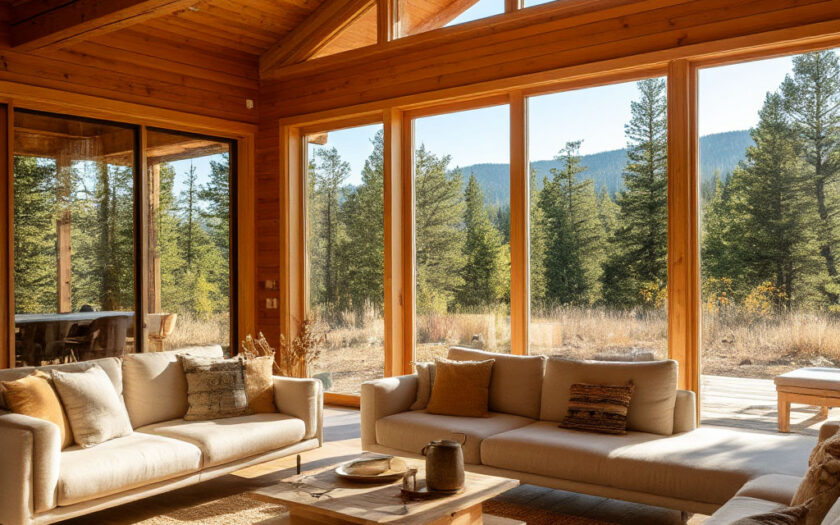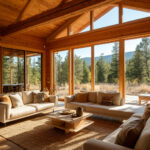The idea of off-grid interior design has taken hold across the country. In 2025, more Americans are choosing freedom from the grid without letting go of comfort or style. These homes may be self-reliant in terms of power and water, but they reflect thoughtful planning and strong aesthetics. People want to live close to nature while still enjoying beautiful spaces that reflect who they are. And now, it’s possible to strike that balance with a touch of rustic interior inspiration.
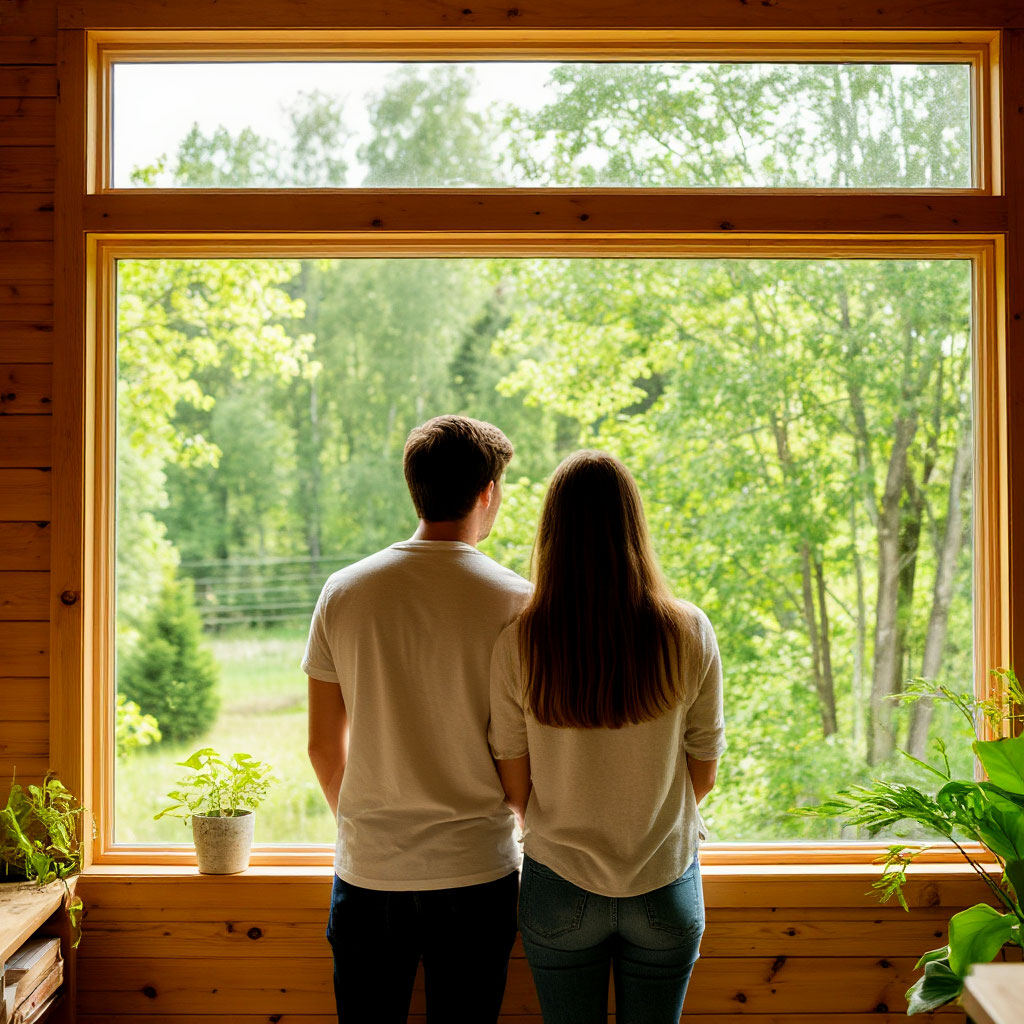
The Rise of Off-Grid Living in Interior Design
The trend toward off-grid living has gained real momentum in recent years. More Americans in 2025 are seeking homes that offer independence from traditional utilities. This shift is driven by a desire for sustainability and self-reliance. The appeal goes beyond energy savings; it reflects a growing need to reconnect with nature and reduce environmental impact. Choosing off-grid homes means embracing a lifestyle that values efficiency, simplicity, and eco-conscious choices. This growing movement has pushed off-grid interior design into the spotlight as a way to merge function with modern style.
Trend Overview Why Americans Choose Off-Grid Homes in 2025
Many people find that living off the grid supports a slower, more intentional way of life. This lifestyle encourages mindfulness about consumption and fosters a deeper connection to the environment. For homeowners, it’s not just about the technical features of a house but the overall experience of living in harmony with nature. These values naturally influence how spaces are planned and decorated, making the interior design just as important as the architecture.
Lifestyle Influence on Interior Design
Lifestyle changes heavily influence how interiors are designed for off-grid homes. People want spaces that support both comfort and responsible living. This means interiors need to be practical but also inviting and warm. The shift toward sustainable off-grid living encourages the use of natural materials and minimalist layouts. Homeowners appreciate interiors that reflect their values — like durability, energy-efficiency, and a connection to the outdoors. As a result, designers focus on creating environments that feel relaxed yet refined, with modern cabin interior ideas that blend rustic charm and contemporary elegance.
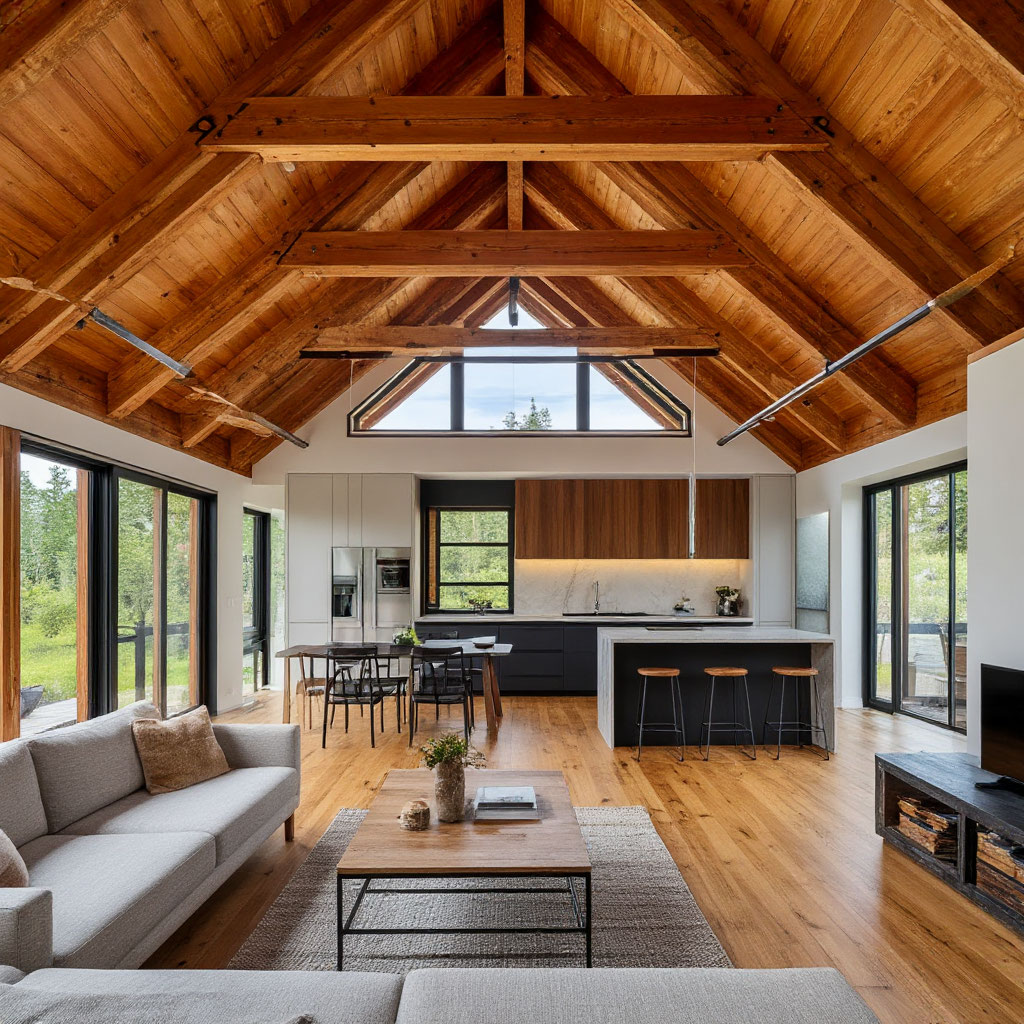
How Rustic Meets Modern in Frame Houses
Modern off-grid homes often take inspiration from rustic interior inspiration, especially in frame house design. This makes them ideal for expressing off-grid interior design in a refined but grounded way. These structures offer strong lines and open layouts while blending natural elements with refined finishes. Inside, exposed beams create an instant connection to rustic traditions. Paired with smooth walls and floor-to-ceiling windows, the effect is both grounded and current.
The materials play a major role. Wood is essential — not just for structure but for its aesthetic value. Whether it’s oak floors or reclaimed pine furniture, the warmth of wood-and-white aesthetics softens clean architectural lines. Metal adds edge. You might see steel-framed staircases or matte black fixtures that contrast with soft textiles. Glass introduces light, letting nature take the lead in the design.
Blending Texture and Tone for Balance
Color palettes favor neutrals, but not in a cold way. Think creamy whites, deep greens, soft browns, and muted grays. These tones feel organic and match the landscape outside. Natural fabrics such as cotton, linen, and wool add depth without overwhelming the room. Even rough textures can look polished when they’re used intentionally.
What truly defines this blend is restraint. Off-grid interior design in frame houses doesn’t try too hard. It avoids clutter, chooses quality over quantity, and celebrates the beauty of raw elements.
Examples of modern-rustic combinations include:
- Frame homes with high ceilings and timber accents.
- Kitchens that mix concrete counters with wooden cabinets.
- Living spaces where stone fireplaces meet clean-lined furniture.
- Bathrooms that pair brushed metal with hand-thrown ceramics.
- Bedrooms with minimal design and soft, layered bedding.
These combinations work well because they balance form and function. Each room feels intentional, not overly styled or busy. The charm comes from the tension between rustic character and sleek precision. Light, warmth, and raw texture come together to create a lived-in look. The result is a space that feels cozy without being cluttered.
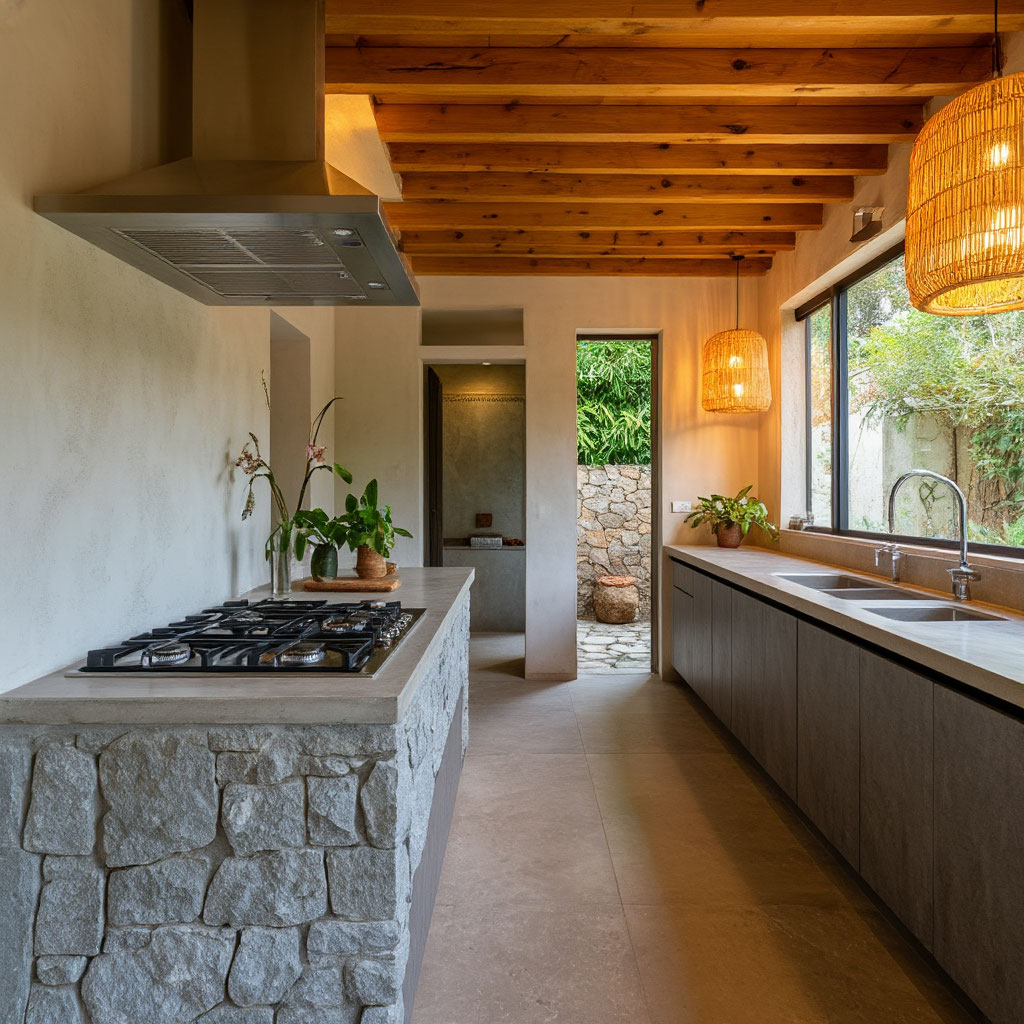
Off-Grid Doesn’t Mean Unstylish — Here’s How
You don’t have to sacrifice design to live off-grid. In fact, the challenge of going off the grid often leads to more creativity. From energy to aesthetics, choices are intentional. Simple additions like solar-powered lighting or battery-operated sconces keep rooms bright without wires. Accent lamps powered by the sun can double as art. These functional pieces often become design highlights.
Modern kitchens in off-grid homes don’t look any different from their on-grid counterparts. That’s one of the key appeals of off-grid interior design — you get the style without giving up function. Gas stovetops, propane refrigerators, and gravity-fed sinks are common. But they’re built into streamlined layouts with clean cabinetry and stylish surfaces. Bathrooms follow a similar logic. Composting toilets, solar water heaters, and low-flow fixtures work alongside glass showers and stone vanities.
Rooms are shaped by what’s necessary — but that doesn’t limit the mood. In fact, the constraint gives a space more character. Choosing fewer items means more focus on quality. And when every object serves a purpose, even a simple room can feel intentional.
Off-grid design example
TLC Cabins showcases sustainable, fully off-grid cabin structures where frame design meets modern living. Explore real-world projects with clever layouts, natural materials, and solar integrations.
Discover how a self-reliant home can still feel refined, warm, and efficient — perfect inspiration for your next interior plan.
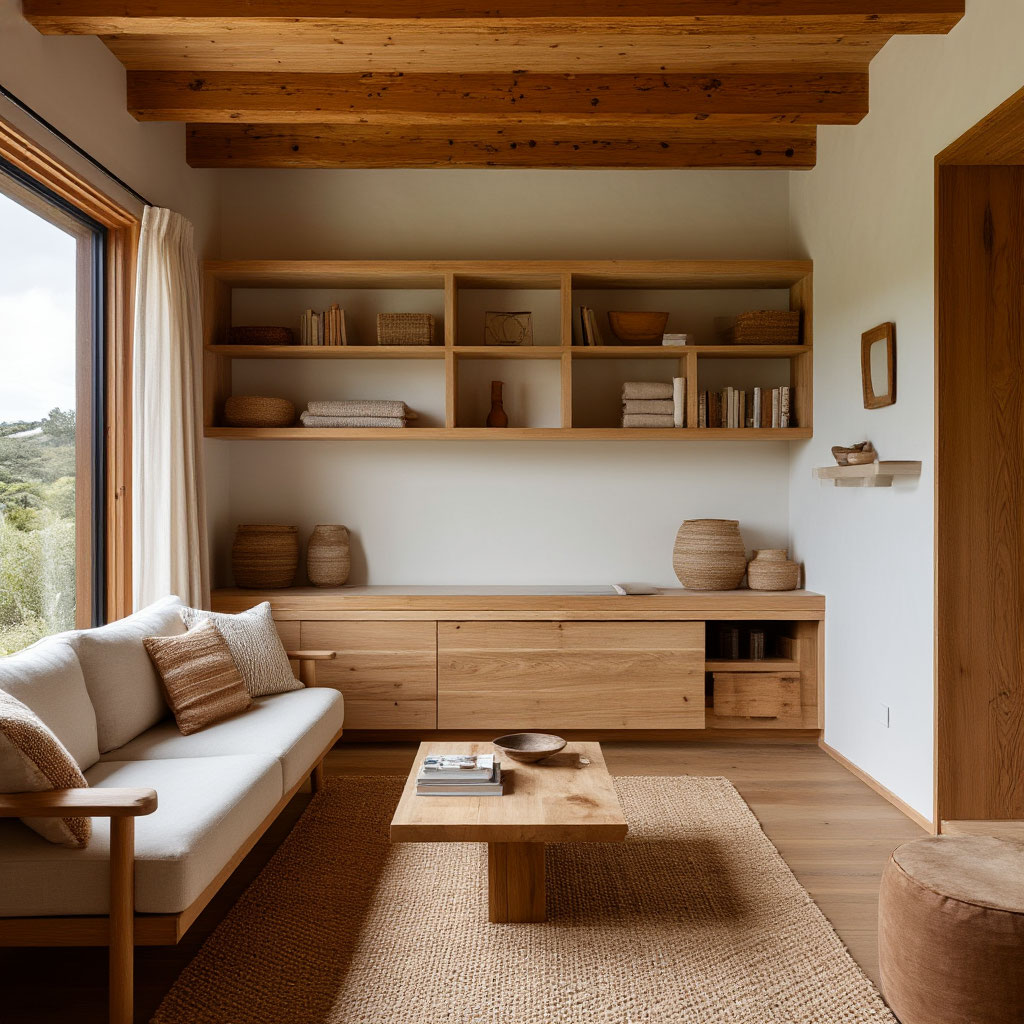
Key Interior Principles for Off-Grid Homes
Designing interiors for off-grid homes requires practical thinking and creative solutions. Since these spaces often face limitations in size, power, and resources, every decision matters. The goal is to create a living environment that feels spacious, comfortable, and efficient without relying on traditional utilities. This involves smart zoning, clever storage, and choosing materials that support low energy use. Let’s explore key principles that make off-grid interiors both livable and stylish.
Zoning and Multifunctionality
Efficient use of space is critical in off-grid homes, where every square foot counts. Zoning means dividing rooms into areas that serve different purposes without needing extra walls. For example, a living room might double as a dining space or a home office. Multifunctional furniture helps here — think fold-out tables or benches with built-in storage. These solutions keep the space open and flexible, which is essential when designing for both comfort and utility. Well-planned zoning reduces clutter and makes daily life smoother by clearly defining each area’s role.
Storage in Small Spaces
Off-grid homes often have limited room for storage, so clever solutions are a must. Hidden compartments under stairs, pull-out drawers built into benches, and shelving tucked into unused corners maximize space. Vertical storage also plays a big role — tall cabinets and wall-mounted hooks free up floor area. Keeping storage multifunctional means less furniture and more open space, improving both movement and airflow. Prioritizing accessible, organized storage makes it easier to maintain a tidy, relaxing environment without overcrowding the home.
Low-Energy Materials
Choosing the right materials affects comfort and energy efficiency. Insulating panels, thermal curtains, and energy-efficient windows help regulate indoor temperatures without excessive power use. Natural fabrics like cotton or linen breathe well and reduce the need for artificial climate control. Low-VOC paints and finishes improve air quality, which is crucial in sealed off-grid homes. Durable, renewable materials such as FSC-certified wood reduce environmental impact while adding natural warmth. Combining these choices helps keep energy consumption low and creates interiors that feel fresh and healthy.
Table: Practical Interior Strategies for Off-Grid Homes
| Challenge | Interior Strategy | Benefit |
| Limited space | Convertible furniture and built-in storage | Maximizes usability without clutter |
| Zoning complexity | Open layouts with defined multifunctional zones | Keeps areas flexible and purposeful |
| Energy efficiency | Use of insulated panels and thermal curtains | Reduces heating and cooling costs |
| Air quality | Low-VOC paints and passive ventilation | Maintains healthy indoor environment |
| Material sustainability | Renewable woods and natural fabrics | Lowers environmental impact |
To summarize, here’s what makes a practical off-grid interior:
- Design rooms with clear but flexible zones.
- Maximize storage with hidden, vertical, and multipurpose solutions.
- Select materials that improve insulation and air quality.
- Use natural, renewable finishes to support sustainability.
These steps help balance comfort with the practical demands of off-grid living. The right interior can make a small, autonomous home feel spacious and welcoming without wasting resources.
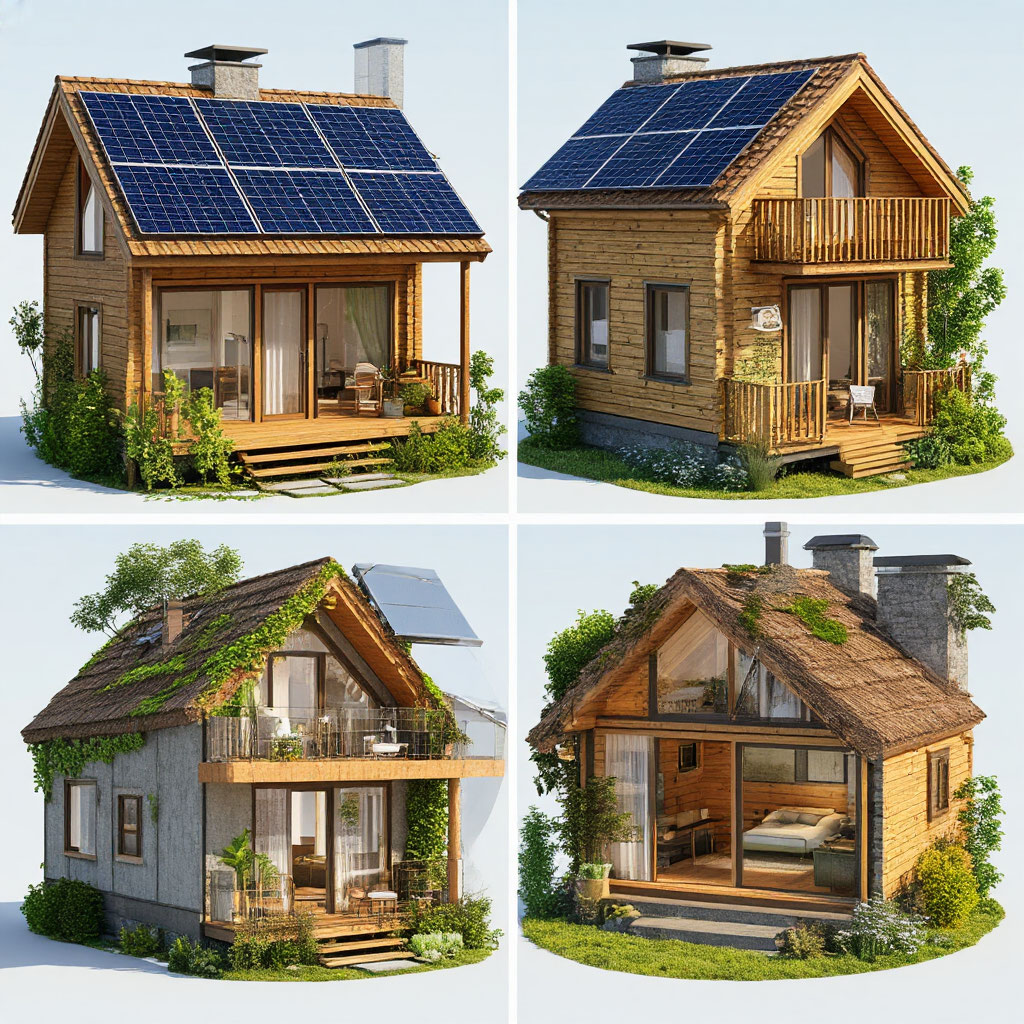
Design Checklist for Your Off-Grid Project
When designing an off-grid home, every detail counts. Because these spaces rely on alternative energy and sustainable solutions, planning becomes essential. The checklist below highlights key areas to focus on, ensuring your interior supports both comfort and efficiency. Thoughtful choices in lighting, ventilation, insulation, and materials will help your home stay cozy and functional year-round.
Lighting
Lighting is a crucial element in off-grid interior design since traditional power sources may be limited or unavailable. Homes rely on solar panels, batteries, and energy-efficient LED fixtures to create a warm and functional atmosphere without high energy costs. Maximizing natural light through well-placed windows and skylights is key. Solar-powered pendants, rechargeable task lamps, and built-in LED strips help layer lighting in kitchens, living spaces, and work areas. This kind of lighting not only saves energy but also adds a modern, clean look that complements rustic interior inspiration. Thoughtful lighting design enhances textures, highlights natural materials, and brings cozy warmth to off-grid homes.
Ventilation
Proper ventilation plays a major role in off-grid homes. While tight insulation and sealed windows help retain heat, they can also limit fresh air circulation. Designers often incorporate passive ventilation systems like trickle vents or operable windows positioned to create natural cross breezes. Energy-efficient ceiling fans running on minimal power help keep air moving without wasting energy. Good ventilation maintains air quality, prevents dampness, and reduces the risk of mold—important factors for comfortable, healthy living. Ultimately, smart airflow supports minimalist nature-based interiors by balancing comfort with sustainability.
Insulation
Effective insulation is a cornerstone of smart off-grid interior design. It helps keep temperatures stable and reduces the need for constant heating or cooling. Eco-friendly insulation materials such as recycled cellulose, natural wool, or foam panels are popular choices. Thermal curtains and double- or triple-pane windows help trap heat during winter and block excessive summer sun. Roof and floor insulation are especially important since a significant amount of heat escapes through these surfaces. Combined with energy-efficient heating solutions like wood stoves or solar-powered radiant floors, insulation keeps the home cozy and energy costs low. This approach is central to sustainable off-grid living.
Sustainability
Sustainability is a guiding principle in off-grid living, shaping material choices and design decisions. Using renewable or recycled materials like FSC-certified wood, organic fabrics, and low-VOC paints helps minimize environmental impact. Energy-saving appliances and water-conserving fixtures further reduce the home’s footprint. This eco-conscious mindset ensures the house isn’t just self-sufficient but also aligned with nature. Sustainable off-grid homes blend functionality with environmental responsibility, supporting a lifestyle that’s both independent and gentle on the planet. This philosophy often extends to solar-powered home design and beyond.
Designer Tips
Professionals recommend starting any off-grid interior design project by thoroughly assessing the site and climate. These factors influence window placement, ventilation strategies, and material selection. Keeping interiors minimal helps maintain simplicity and function without clutter. Multi-purpose furniture and clever zoning make the most of limited space. Designers also emphasize integrating reliable, low-maintenance technologies that support energy independence. At the same time, creating warmth through natural textures and soft color palettes makes the space inviting. This balanced approach ensures off-grid interior design is both sustainable and comfortable.
Off-grid interior design is more than a trend. It’s a way to rethink what homes can be — elegant, efficient, and connected to nature. Blending rustic interior inspiration with modern comfort opens new doors in architecture and lifestyle. Whether you’re building from scratch or updating an existing space, the core ideas remain the same: simplicity, functionality, and intention. It’s proof that living off-grid doesn’t mean giving up beauty — it just means designing with purpose.
